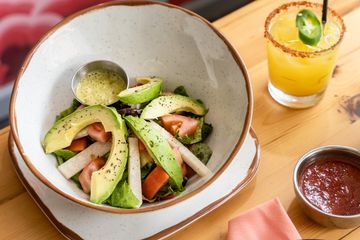Join coworkers for happy hour featuring Mexican appetizers and more
Why Mexican Cuisine Is Famous: Discovering the Cultural Value Behind the Dishes
Mexican cuisine sticks out for its dynamic tastes and deep social roots. The fusion of native and Spanish impacts develops a distinct cooking identification. Each meal narrates of party, neighborhood, and tradition. Components like corn and chili peppers play essential duties fit these narratives. To recognize the complete significance of these cooking methods, one need to discover the layers of background and significance that improve every bite. What lies beneath the surface of this precious food?
The Historical Origins of Mexican Food
Mexican food is typically celebrated for its diverse components and vibrant tastes, its historical roots run deep, reflecting an abundant tapestry of social influences. Stemming from ancient Mesoamerican human beings, such as the Aztecs and Mayans, Mexican food progressed through centuries of farming methods that incorporated neighborhood plants like maize, beans, and chili peppers. The arrival of Spanish colonizers in the 16th century introduced brand-new ingredients, including pork, rice, and dairy products, which combined with aboriginal practices to create special cooking fusions. This blend of influences not just shaped the dishes but also stood for the cultural and social dynamics of the moment. For many years, regional variations emerged, affected by geography, climate, and regional personalizeds. Consequently, Mexican food stands as a representation of its historical trip, personifying the resilience and flexibility of its people while commemorating their heritage via food.
Regional Variety and Its Effect On Flavors
Regional variety plays an important role fit the tastes of Mexican food, with each area contributing special components based on neighborhood agriculture and practice. Traditional food preparation techniques further boost these tastes, reflecting the custom-mades and histories of individuals. In addition, the differing environments throughout Mexico influence which ingredients grow, leading to unique regional recipes that celebrate the country's culinary splendor.
Special Components by Area
Mexican cuisine showcases an exceptional array of one-of-a-kind active ingredients that differ substantially across its diverse areas, each adding distinct flavors and cooking techniques. In the coastal locations, seafood such as shrimp and fish are staples, usually paired with tropical fruits like mango and coconut. The main highlands are known for their abundant range of beans, corn, and squash, creating the basis of lots of conventional dishes. In the Yucatán Peninsula, achiote and sour oranges convey an unique taste profile, while the north areas prefer beef and wheat-based meals, reflecting the influence of bordering cultures. Each area's environment and geography shape the local components, producing a dynamic tapestry of tastes that highlight Mexico's rich cooking heritage.

Standard Food Preparation Methods
The varied active ingredients located throughout Mexico not only shape the meals but also influence the typical cooking strategies made use of in each area. For circumstances, in Oaxaca, making use of a stone mortar and pestle, understood as a "metate," is prevalent for grinding corn and flavors to produce masa and mole. On the other hand, coastal areas often utilize barbecuing and steaming techniques to prepare seafood, reflecting their accessibility to fresh catch. The highlands may highlight slow-cooking techniques, such as barbacoa, where meats are covered in maguey leaves and hidden in the ground. Each method is deeply rooted in the local society, showcasing the importance of practice while enhancing the distinctive tastes that identify Mexican cuisine throughout varied landscapes.
Environment's Flavor Influence
Although climate differs substantially throughout Mexico, it plays an essential duty fit the tastes and components that specify the country's cuisine. Different regions experience distinctive climate patterns, influencing the agricultural result and culinary practices. For example, the arid north is known for its passionate meats, while the lavish south deals an abundance of exotic fruits and veggies. Coastal areas take advantage of fresh seafood, which ends up being a staple in their dishes. Additionally, the highlands create distinct natural herbs and flavors that contribute to regional specializeds. This weather diversity not only enhances the taste profiles of Mexican cuisine but likewise mirrors the social identity of each area, showcasing the deep connection between the setting and culinary heritage.
The Duty of Active Ingredients in Culinary Identification
Vital to comprehending cooking identity, the components of a food disclose deep cultural connections and historical narratives. In Mexican cuisine, staples such as corn, beans, and chili peppers offer not just as foundational elements however likewise as icons of durability and adaptation. Corn, for circumstances, is spiritual, showing its relevance to indigenous cultures and farming techniques. The selection of beans showcases the nation's biodiversity, while chili peppers include deepness and heat, standing for regional variations and cooking creativity.
These active ingredients are intertwined with rituals, practices, and neighborhood customs, highlighting the importance of location fit cooking identification. The combination of herbs like cilantro and seasonings such as cumin more improves the taste account, demonstrating the influence of both early american histories and indigenous techniques. Collectively, these parts create a lively tapestry that mirrors the intricacies of Mexican culture, making its cuisine a powerful expression of identity and heritage.
Standard Cooking Techniques and Their Significance
Traditional cooking strategies in Mexican food work as a necessary web link to the country's heritage, protecting old methods passed down via generations. These methods not only mirror local diversity yet also boost the one-of-a-kind flavors that specify the cuisine. Comprehending their value reveals the social richness installed in every meal.
Old Techniques Protecting Heritage
While modern cooking methods have transformed the landscape of Mexican food, old methods continue to be a vital link to the country's abundant heritage. Strategies such as nixtamalization, the process of dealing with corn with lime to boost its dietary value, have actually been critical in shaping typical recipes. The use of clay pots and rock mortars, called molcajetes, also reflects the emphasis on credibility and flavor that has been given via generations. These methods not just preserve the integrity of active ingredients but also personify public worths and cultural practices. By proceeding to employ these old strategies, contemporary Mexican chefs preserve a connection to their ancestors, ensuring that the cookeries continue to be dynamic and reflective of the country's diverse background.
Regional Techniques and Flavors
As varied as its landscapes, Mexican food is characterized by a myriad of local methods and tastes article source that mirror the one-of-a-kind social impacts and neighborhood components of each location. In Oaxaca, the usage of the comal for food preparation tortillas demonstrates a tradition gave with generations, while the Yucatán area showcases the slow-cooking approach understood as cochinita pibil, stressing marinated pork wrapped in banana leaves. Coastal locations highlight seafood preparations, with china garden techniques like ceviche reflecting indigenous and Spanish impacts. Each area's distinctive seasonings, such as the great smoky chipotle from Veracruz or the vivid chilies from Puebla, contribute to a rich tapestry of flavors - take out and delivery. These conventional approaches not just improve culinary variety however additionally function as a representation of the resilience and creativity of Mexican society
Festivities and parties: Food as a Social Expression
Parties and celebrations in Mexico are typically marked by a variety of vibrant meals that show the country's abundant social heritage. Conventional meals, such as tamales during Día de los Muertos and pozole throughout Freedom Day, display local components and cooking methods, symbolizing area and familial bonds. Food ends up being a medium for storytelling, with each dish lugging historical value and local identities.
Along with the meals themselves, the rituals bordering food prep work and usage play a necessary role in these celebrations. Families collect to create elaborate meals, cultivating connections and protecting customs gave through generations. The communal nature of these cooking techniques highlights the value of sharing food as an expression of love and unity. With these joyful gatherings, Mexican cuisine goes beyond simple nutrients, acting as a social symbol that celebrates heritage, spirituality, and the delight of togetherness.
Global Impact and Recognition of Mexican Gastronomy
Exactly how has Mexican gastronomy obtained such extensive praise worldwide? The response hinges on its dynamic tastes, diverse active ingredients, and abundant social heritage that reverberate globally. Acknowledged by UNESCO as an Abstract Cultural Heritage of Humankind, Mexican food showcases an unique mix of aboriginal and Spanish impacts, making it distinct and appealing.
Restaurants concentrating on Mexican meals have multiplied internationally, introducing genuine flavors such as mole, tacos, and tamales to varied palates. The appeal of Mexican food has actually additionally been bolstered by celeb cooks and cooking programs, which highlight its cooking techniques and traditions.
Furthermore, food events and cultural events celebrate Mexican gastronomy, additional boosting its standing on the world stage. As a result, Mexican cuisine goes beyond boundaries, promoting admiration for its historical value and cooking artistry, guaranteeing its long-lasting influence in the worldwide cooking landscape.
Regularly Asked Concerns
What Are the Health And Wellness Perks of Standard Mexican Meals?
Conventional Mexican dishes supply numerous wellness benefits, including high fiber web content from beans and vegetables, healthy fats from avocados, and important nutrients from spices. These active ingredients add to enhanced digestion, heart health and wellness, and general health.

Just How Can I Recreate Authentic Mexican Dishes in your home?
To recreate genuine Mexican recipes at home, one should source fresh components, make use of typical food preparation techniques, check out local variants, and follow reliable recipes while accepting the cultural subtleties and vivid flavors fundamental in Mexican food. (freshly made guacamole)
What Role Do Seasonings Play in Mexican Food Preparation?
Seasonings are necessary in Mexican food preparation, improving flavors and aromas. They give depth and intricacy to dishes, reflecting regional variety. Typical flavors like chili, oregano, and cumin add to dragon house the vivid, vibrant profiles characteristic of Mexican cuisine.
Exist Vegetarian or Vegan Options in Mexican Food?
Yes, Mexican cuisine uses various vegan and vegan options. Meals such as chiles rellenos, nopales, and various bean preparations showcase the rich flavors and active ingredients readily available, making it accessible for those following plant-based diet regimens.
Exactly How Has Mexican Food Influenced Various Other International Foods?
Mexican food has actually greatly affected international foods with the intro of ingredients like corn, beans, and chili peppers, inspiring fusion dishes and enhancing flavor profiles in numerous cooking customs, especially in the United States and Latin America.
Mexican cuisine stands out for its dynamic flavors and deep social origins. Mexican cuisine is usually commemorated for its varied components and lively tastes, its historic roots run deep, showing an abundant tapestry of social impacts. Regional variety plays a vital role in shaping the tastes of Mexican cuisine, with each location contributing one-of-a-kind active ingredients based on regional farming and tradition. Mexican cuisine showcases an amazing array of one-of-a-kind ingredients that vary significantly throughout its varied areas, each adding distinct tastes and cooking methods. As varied as its landscapes, Mexican cuisine is characterized by a myriad of local strategies and tastes that show the distinct cultural impacts and regional active ingredients of each area.